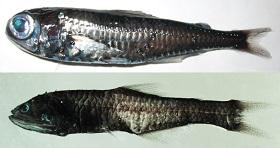Using AI to control energy for indoor agriculture
30 September 2024
Published online 6 March 2014

The biomass of mesopelagic fishes – which live at depths between 200 and 1000 metres under the ocean's surface – is ten times higher than the 1000 million tonnes previously estimated from trawling activities.
A team of researchers, led by the director of the Red Sea Center at King Abdullah University of Science and Technology, Xabier Irigoien, published their findings this month in Nature Communications1. Their results came from acoustic observations taken during Malaspina 2010, a Spanish circumnavigation expedition. Based on this data, the researchers say that mesopelagic fishes' biomass is about one order of magnitude higher than what they thought.
The primary goal of the expedition, between 2010 and 2011, was to gain a better understanding of the deep ocean, and the team, led by Irigoien, used a Simrad EK60 echo sounder operating at 38 kHz frequency to obtain data on mesopelagic fish biomass throughout the 32,000 miles' (51,500 kilometres) navigation.
The authors used acoustic measurements, a sensitivity analysis of acoustic data, complemented by modeling based on satellite data on primary productivity and temperature.
"That fish populations were underestimated shows that our understanding of the deep ocean is really poor and that expeditions like Malaspina are needed," said Irigoien.
The mesopelagic zone, located between the sunlit surface waters and the black abyss below, is home to the most abundant vertebrate population on Earth. The centimetres-long mesopelagic Cyclothone fish has the ability to escape trawlers' catch, which explains why the biomass of mesopelagic fish was so underestimated.
The importance of oceans in capturing energy and regulating carbon will likely increase.
Each night, schools of mesopelagic fish swim up from the deep ocean to the surface to feed on drifting zooplankton, before descending again at dawn having consumed a significant quantity of organic material.
According to Ameer Abdulla, senior research fellow in marine conservation science at the University of Queensland, Australia, and senior advisor in marine biodiversity and conservation science with the Global Marine and Polar Program of the International Union for Conservation of Nature (IUCN), mesopelagic fishes undertake perhaps the largest vertebrate migration in the biosphere due to their substantial biomass.
By doing so, they capture large quantities of carbon and release it into the deep waters much faster than any other organism. "This feeding behavior and movement transports organic matter including carbon from the surface to deeper waters where it can be more readily used in deeper trophic food webs and biogeochemical cycles," says Abdulla.
This efficient CO2 flux was already known, but the quantity captured and transported had been miscalculated. "It was previously thought that in the open ocean, the efficiency of the food chain was lower than in the coastal areas, because phytoplankton is smaller," says Irigoien.
However, the new study shows how mesopelagic fishes accelerate the 'biological pump' by eliminating CO2 from the surface waters and transforming it in the form of feces in deeper ocean layers. Consequently, open ocean's ecosystems are as efficient at moving nutrients and energy generated by primary producers as coastal areas.
Abdulla explains that since pelagic and deep-sea waters cover 66% of the Earth, the potential to harness and hold such high trophic energy is unsurprising. "The importance of oceans in capturing energy and regulating carbon will likely increase as oceanographic and marine science improve through technological advances and habitat access," he adds.
In order to gather more accurate estimates and guarantee a better understanding of the mesopelagic community composition and acoustic properties, Abdulla recommends using enhanced acoustic technology and conduct expeditions in other representative regions with differing primary productivity.
His view is backed by the KAUST researchers, whose paper concludes: "These findings calls for an effort to improve the accuracy of the estimates of the biomass and composition of the mesopelagic fishes and obtain detailed target strengths."
doi:10.1038/nmiddleeast.2014.57
Stay connected: